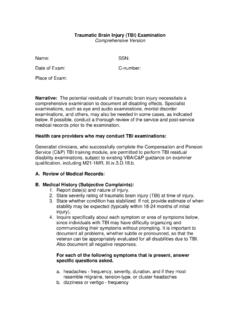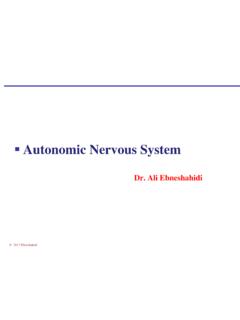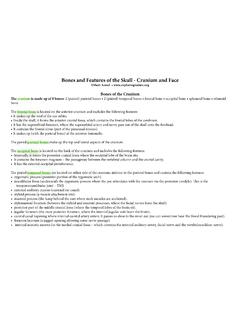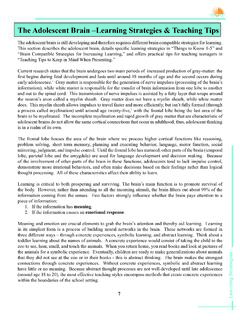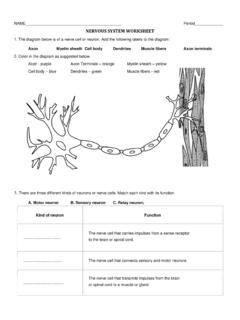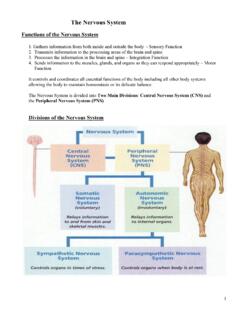Transcription of Examination and Diseases of Cranial Nerves CN I ...
1 2018 All rights nerve evaluation is an important part of a neurologic exam. There are some differences in the assessment of Cranial Nerves with different species but the general principles are the same. Going into a board exam, you should know the names and functions of the 12 pairs of Cranial Nerves and be able to recognize dysfunction. This PowerPage reviews the Cranial Nerves and how to examine their function as well as a few specific disorders that can affect them. They may also be affected by focal or multifocal central nervous system lesions of any Function and Examination of Cranial NervesCN I - Olfactory Nerve Mediates the sense of smell. Rarely has a primary neurologic problem. Examined by observing patient sniff II - Optic Nerve Carries visual signals from retina to occipital lobe of brain.
2 Examine a cotton ball and watch the patient follow it to the ground (II only). response (II for visual cue and VII for blink response). light response or PLR (II for visual cue and III for pupil constriction) ipsilateral and contralateral constriction to differentiate the response III - Oculomotor Nerve Provides motor to most of the extraocular muscles (dorsal, ventral, and medial rectus) and for pupil constriction. Examine for physiologic nystagmus when turning head (also involves IV, VI, and VIII). pupillary constriction in and Diseases of Cranial Nerves1 2018 All rights IV - Trochlear Nerve Provides motor function to the dorsal oblique extraocular muscle and rolls globe medially. Examine by observing for dorsolateral rotation of the V - Trigeminal NerveMaxillary, Mandibular and Ophthalmic Branches Provides motor to muscles of mastication (masseter, temporal) and sensory to eyelids, cornea, tongue, nasal mucosa and mouth.
3 Examine masseter and temporal muscles for symmetry, atrophy, and jaw medial septum of nose and look for the globe and observing for retraction (also tests VI for motor). response -blink reflex when touching medial canthus (also tests VII for motor). the lip and observing for snarl response (also tests VII for motor).CN VI - Abducens Nerve Provides motor function to the lateral rectus extraocular muscle and retractor bulbi. Examine the globe and observing for retraction (also tests V for sensory). for medial for physiologic nystagmus when turning head (also involves III, IV, and VIII).CN VII - Facial Nerve Provides motor to muscles of facial expression (eyelids, ears, lips) and sensory to medial pinna. Also taste to rostral tongue and parasympathetic innervation to lacrimal glands and some salivary glands.
4 Examine response (II for visual cue and VII for blink response). response -blink reflex when touching medial canthus (also tests V for sensory). for facial paralysis, deviation of nose to one side, or droopy tear flick in response to stimulation of medial and Diseases of Cranial Nerves2 2018 All rights VIII - Vestibulocochlear Nerve Sensory input for hearing and head position. Examine assessment; deaf animals may startle for head tilt, abnormal nystagmus, and presence of normal physiologic nystagmus (see PowerPage on Vestibular Disease for more detail).CN IX - Glossopharyngeal Nerve Provides motor and sensory innervation to pharynx for swallowing (with X). Also innervates some salivary glands and provides taste innervation from caudal tongue. Examine by eliciting a gag reflex and observing for X - Vagus Nerve Innervates the larynx, esophagus, and pharynx.
5 Also provides parasympathetic innervation to the heart and viscera. Examine a gag for laryngeal for megaesophagus and XI - Spinal Accessory Nerve Innervates Cranial cervical muscles. Rarely assessed and rarely a clinical XII - Hypoglossal Nerve Provides motor to the tongue. Examine by observing tongue movement and symmetry or for problems drinking and prehending and Diseases of Cranial Nerves3 2018 All rights AidsThere are many mnemonic aids that have been used to help remember the names and functions of the Cranial Nerves . For a list of over 20 clever aids (you should just pick the one that helps you the most), follow this link: Disorders of Cranial NervesSome specific Cranial nerve disorders are seen, particularly in dogs. CN VIII syndromes are reviewed on the Vestibular Disease PowerPage.
6 Idiopathic trigeminal neuritis and facial nerve paralysis are briefly reviewed Trigeminal Neuritis A syndrome seen in dogs with peracute onset of a dropped jaw and inability to close the mouth. No other sensory deficits or other Cranial nerve deficits are present. Dogs are typically normally alert and responsive without difficulty swallowing foodthat is placed on the back of the tongue. Should be distinguished from these differentials (usually based on speed of onset and lack of other signs) of mandibular muscle myositis Treated with supportive care with fluids and hand feeding of soft food a prognosis is excellent, with most dogs regaining function within 1-2 weeks and returning to normal within 3-4 Facial Nerve Paralysis Acute onset of several to blink (lack of menace or palpebral response).
7 Lip and from one side of the eye. Facial sensation is and Diseases of Cranial Nerves4 2018 All rights Facial Nerve Paralysis (Cont.) Should be distinguished from these differentials (usually based on speed of onset and lack of other signs) of the facial disease Best treatment is controversial but may consist of tear supplementation, thyroid supplementation (if concurrent hypothyroidism), immunosuppressive doses of glucocorticoids. Prognosis is fair as complete recovery often does not occur, but most dogs can function well with these moderate deficits and only need long term tear and Diseases of Cranial Nerves5

